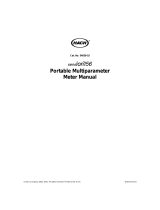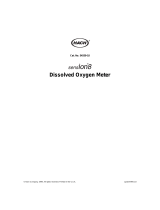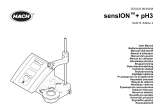
51700-18
Portable pH Meter
Instruction Manual
© Hach Company, 1999, 2000. All rights reserved. Printed in the U.S.A. hm/dk 3/99 1ed
jnb/dk 9/00 rev4

2
TRADEMARKS OF HACH COMPANY
AccuGrow
®
AccuVac
®
AccuVer™
AccuVial™
Add-A-Test™
AgriTrak™
AluVer
®
AmVer™
APA 6000™
AquaChek™
AquaTrend
®
BariVer
®
BODTrak™
BoroTrace™
BoroVer
®
C. Moore Green™
CA 610™
CalVer
®
ChromaVer
®
ColorQuik
®
CoolTrak
®
CuVer
®
CyaniVer
®
Digesdahl
®
DithiVer
®
Dr. F. Fluent™
Dr. H.Tueau™
DR/Check™
EC 310™
FerroMo
®
FerroVer
®
FerroZine
®
FilterTrak™ 660
Formula 2533™
Formula 2589™
Gelex
®
H
2
O University™
H
2
OU™
Hach Logo
®
Hach One
®
Hach Oval
®
Hach.com™
HachLink™
Hawkeye The Hach Guy™
HexaVer
®
HgEx™
HydraVer
®
ICE-PIC™
IncuTrol
®
Just Add Water™
LeadTrak
®
M-ColiBlue24
®
ManVer
®
MolyVer
®
Mug-O-Meter
®
NetSketcher™
NitraVer
®
NitriVer
®
NTrak
®
OASIS™
On Site Analysis.
ResultsYou Can Trust
OptiQuant™
OriFlow™
OxyVer™
PathoScreen™
PbEx
®
PermaChem
®
PhosVer
®
Pocket Colorimeter™
Pocket Pal™
Pocket Turbidimeter™
Pond In Pillow™
PourRite
®
PrepTab™
ProNetic™
Pump Colorimeter™
QuanTab
®
Rapid Liquid™
RapidSilver™
Ratio™
RoVer
®
™
Simply Accurate
SINGLET™
SofChek™
SoilSYS™
SP 510™
Spec ™
StablCal
®
StannaVer
®
SteriChek™
StillVer
®
SulfaVer
®
Surface Scatter
®
TanniVer
®
TenSette
®
Test ‘N Tube™
TestYES!
TitraStir
®
TitraVer
®
ToxTrak™
UniVer
®
VIScreen™
Voluette
®
WasteAway™
ZincoVer
®
SM
SM
SM
sens
ion
√

3
TABLE OF CONTENTS
CERTIFICATION ..................................................................................................................... 5
SAFETY PRECAUTIONS ....................................................................................................... 7
SPECIFICATIONS.................................................................................................................... 9
OPERATION........................................................................................................................11
SECTION 1 INTRODUCTION........................................................................................... 13
1.1 Unpacking the Instrument................................................................................................. 13
1.1.1 Standard Accessories............................................................................................... 13
1.2 Keypad Description........................................................................................................... 15
1.3 Display Fields and Icons................................................................................................... 16
1.4 Audible Signals................................................................................................................. 18
SECTION 2 INSTRUMENT SETUP.................................................................................. 19
2.1 Instrument Description...................................................................................................... 19
2.2 Battery Installation............................................................................................................ 19
2.3 Probe Connections............................................................................................................. 21
2.3.1 Temperature Probe Connection ............................................................................... 22
2.4 Turning the Meter On........................................................................................................ 22
2.5 Temperature Measurement................................................................................................ 22
2.6 Millivolt Measurements .................................................................................................... 23
2.7 Automatic Shut-off Function ............................................................................................ 23
SECTION 3 INSTRUMENT OPERATION....................................................................... 25
3.1 Setup Menu ....................................................................................................................... 25
3.1.1 Choosing the Probe Connector................................................................................ 25
3.1.2 Turning Display Lock Off and On........................................................................... 26
3.1.3 Selecting Temperature Units.................................................................................... 26
3.1.4 Selecting Measurement Resolution ......................................................................... 27
3.1.5 Selecting Auto Buffer Recognition.......................................................................... 27
3.2 Calibrating the Meter ........................................................................................................ 27
3.2.1 Performing a Calibration Using pH 4, 6.86, 7, and 10 Buffers ............................... 28
3.3 Reviewing the Calibration................................................................................................. 29
3.4 Measuring Samples........................................................................................................... 30

4
TABLE OF CONTENTS, continued
SECTION 4 TROUBLESHOOTING ................................................................................. 31
4.1 Introduction....................................................................................................................... 31
4.2 Shorting Test..................................................................................................................... 31
4.3 Error Codes....................................................................................................................... 32
4.4 Meter Service Request Questionnaire............................................................................... 32
GENERAL INFORMATION........................................................................................... 33
REPLACEMENT PARTS....................................................................................................... 35
HOW TO ORDER.................................................................................................................. 37
REPAIR SERVICE ................................................................................................................. 38
WARRANTY.......................................................................................................................... 39

5
CERTIFICATION
Hach Company certifies this instrument was tested thoroughly,
inspected, and found to meet its published specifications when it
was shipped from the factory.
The sens
ion
™
1 Portable pH Meter has been tested and is
certified as indicated to the following instrumentation standards:
EMI Immunity:
Per 89/336/EEC EMC: EN 61326:1998 (Electrical Equipment
for measurement, control, and laboratory use— EMC
requirements) Supporting test records by Hach Company,
certified compliance by Hach Company.
Standards include:
IEC 1000-4-2:1995 (EN 61000-4-2) Electro-Static Discharge
(Criteria B)
IEC 1000-4-3:1995 (EN 61000-4-3:1995) Radiated RF
Electro-Magnetic Field Immunity (Criteria B)
ENV 50204:1996 Radiated Electro-Magnetic Field from
Digital Telephones (Criteria B)
Radio Frequency Emissions:
Per 89/336/EEC EMC: EN 61326:1998 (Electrical Equipment
for measurement, control, and laboratory use— EMC
requirements) Class B emission limits. Supporting test records by
Criterion Technology O.A.T.S. (NVLAP #0369), certified
compliance by Hach Company.
Additional Emissions Standard/s include:
EN 55011 (CISPR 11) Emissions, Class B Limits
CANADIAN INTERFERENCE-CAUSING EQUIPMENT
REGULATION, IECS-003: Class A emission limits.
Supporting test records by Criterion Technology O.A.T.S.
(NVLAP #0369), certified compliance by Hach Company.
This Class A digital apparatus meets all requirements of the
Canadian Interference-Causing Equipment Regulations.

6
CERTIFICATION, continued
Cet appareil numérique de la classe A respecte toutes les
exigences du Règlement sur le matériel brouilleur du Canada.
FCC PART 15, Class “A” Limits:
Supporting test records by Criterion Technology O.A.T.S.
(NVLAP #0369), certified compliance by Hach Company.
This device complies with Part 15 of the FCC Rules. Operation is
subject to the following two conditions:
(1) This device may not cause harmful interference, and (2) this
device must accept any interference received, including
interference that may cause undesired operation.
Changes or modifications to this unit not expressly approved by
the party responsible for compliance could void the user's
authority to operate the equipment.
This equipment has been tested and found to comply with the
limits for a Class A digital device, pursuant to Part 15 of the FCC
Rules. These limits are designed to provide reasonable protection
against harmful interference when the equipment is operated in a
commercial environment. This equipment generates, uses, and
can radiate radio frequency energy and, if not installed and used
in accordance with the instruction manual, may cause harmful
interference to radio communications. Operation of this
equipment in a residential area is likely to cause harmful
interference, in which case the user will be required to correct the
interference at his own expense. The following techniques of
reducing the interference problems are applied easily:
1. Remove power from the sens
ion1 pH meter by removing
one of its batteries to verify that it is or is not the source of
the interference.
2. Move the meter away from the device receiving
the interference.
3. Reposition the receiving antenna for the device receiving
the interference.
4. Try combinations of the above.

8

9
SPECIFICATIONS
Specification subject to change without notice.
pH mode
Range -2.00 to 19.99
Resolution (selectable) 0.001/0.01/0.1
Slope range 58 ±3 mV/decade
Millivolt mode
Range -2000 to 2000 mV
Resolution 0.1 mV
Accuracy 0.2 mV or ±0.01% of reading, whichever is greater
Temperature mode
Range -10.0 to 110 °C (can also display °F)
Resolution 0.1 °C
Accuracy ±0.3 from 0–70 °C; ±1.0 from >70–110 °C
Display: Custom LCD
Inputs: 1 BNC; 5-pin Hach pH/temperature or Hach temperature probe; 1 pin-tip
Power Requirements: 4 alkaline AA batteries
Input Impedance: >10
12
ohms
Instrument Drift: <40 µV/°C
Input Bias Current: <±1 picoamp at 25 °C; <±4 picoamp over full range
Environmental Requirements: 0 to 50 °C at 85% non-condensing relative humidity
Dimensions: 21.2 x 8.7 x 4.2 cm (8.35 x 3.43 x 1.65 in.)
Enclosure: Waterproof (designed to meet IP67), chemical resistant, dust proof; meter will
float.

10

11
DANGER
Handling chemical samples, standards, and reagents can be dangerous. Review the necessary
Material Safety Data Sheets and become familiar with all safety procedures before handling
any chemicals.
DANGER
La manipulation des échantillons chimiques, étalons et réactifs peut être dangereuse. Lire les Fiches
de Données de Sécurité des Produits (FDSP) et se familiariser avec toutes les procédures de sécurité
avant de manipuler tous les produits chimiques.
PELIGRO
La manipulación de muestras químicas, estándares y reactivos puede ser peligrosa. Revise las fichas
de seguridad de materiales y familiarícese con los procedimientos de seguridad antes de manipular
productos químicos.
GEFAHR
Das Arbeiten mit chemischen Proben, Standards und Reagenzien ist mit Gefahren verbunden.
Es wird dem Benutzer dieser Produkte empfohlen, sich vor der Arbeit mit sicheren Verfahrensweisen
und dem richtigen Gebrauch der Chemikalien vertraut zu machen und alle entsprechenden
Materialsicherheitsdatenblätter aufmerksam zu lesen.
PERIGO
A manipulação de amostras, padrões e reagentes químicos pode ser perigosa. Reveja a folha dos
dados de segurança do material e familiarize-se com todos os procedimentos de segurança antes
de manipular quaisquer produtos químicos.
OPERATION

12

13
SECTION 1 INTRODUCTION
This manual describes the operation and use of the Hach
sens
ion
™
1 Portable pH/mV/Temperature Meter (see Figure 1).
This meter features a custom digital LCD display which
simultaneously shows temperature and measurement results. This
meter has all the features of a simple pH meter plus a millivolt
mode, IP67 waterproof design, electrode holder, ergonomic
design, and automatic buffer recognition.
The electrode holder on the back of the instrument allows the user
to store the electrode and meter in one convenient package when
not in use. The electrode holder is designed so the user can slip a
vinyl electrode cover over the electrode tip, creating a humid
environment that allows the electrode membrane to remain
hydrated when not in use (see Figure 2 Electrode Holder).
The meter is designed to be maintenance-free. If the meter gets
dirty, wipe the surface with a damp cloth. Use a cotton-tipped
applicator to clean or dry the connectors if they get wet.
1.1 Unpacking the Instrument
Remove the instrument and accessories from the shipping
container and inspect each item for any damage that may have
occurred during shipping. Verify that all items listed on the
packing slip are included. If any items are missing or damaged,
contact Hach Customer Service, Loveland, Colorado for
instructions. Hach’s toll free phone number for customers within
the United States is 800-227-4224. For customers outside the
United States, contact the Hach office or distributor serving you.
1.1.1 Standard Accessories
• Batteries - 4 alkaline AA (not rechargeable)
• Instrument Manual
• May include electrode and related accessories (covered in the
electrode manual).

14
SECTION 1, continued
Figure 1 Hach sension1 Meter
Figure 2 Electrode Holder

15
SECTION 1, continued
1.2 Keypad Description
Figure 3 illustrates the meter’s keypad. The description and
function of each key is given in Table 1.
Figure 3 sension1 Meter Keypad
Table 1 Keys and Description
Key Description
Exit/Power On-Off Turns the instrument on; turns it off from the Reading mode.
Acts as a NO or CANCEL key when the question mark icon is flashing.
Performs the following and returns to the Reading mode:
• Exits the Setup mode
• Aborts a calibration
• Exits a calibration review
Arrow Keys Scroll between options in Setup mode.
Change the default temperature when a temperature probe is not in use.
In Setup mode, back up one step toward the Reading mode.
READ/ENTER
Key
Acts as a YES key when the question mark is flashing.
Allows user to edit a setup when the setup number is flashing.
Initiates a new measurement when the meter has stabilized in the Display Lock
Enabled mode.
pH/mV Key Toggles between pH value and mV value in Reading, Calibration, and Cal Review
modes.
Setup Key Enters Setup mode (from Reading mode only).
Cal Key Enters Calibration mode (from Reading mode only).
Review Key Enters Calibration Review mode (from Reading mode only).

16
SECTION 1, continued
1.3 Display Fields and Icons
The display has two screens. The upper screen displays
measurements or standard values, the operation mode in use,
slope, sample/default temperature, pH or mV units, error codes,
and indicates if the meter reading is stable. The lower screen
displays the acrive keys.
Figure 4 shows the icons and screens displayed by the meter and
Table 2 describes each element. Several icons on the display are
not used by the portable pH sens
ion1 meter (indicated by NA in
the table), but will be displayed if the power key is held down for
several seconds.
Figure 4 Display Elements

17
SECTION 1, continued
Table 2 Main Display Elements
Item No. Description
1 Indicates meter is in Calibration mode. If the ? is flashing, calibration is necessary.
2 Indicates meter is in Calibration Review mode.
3 (NA) Indicates data is being sent to a printer/computer.
4 (NA) Indicates recalled data that is currently displayed is being erased.
5 Indicates meter is in Setup mode.
6 (NA) Indicates all data points are being printed or erased.
7 Numerical field that displays Setup, Sample, and Standard numbers when those words are
displayed with the number. If
Standard and 1 are displayed, the meter is measuring
Standard 1.
8 Flashing
? and CAL indicate calibration is necessary. Also a prompt to press the ENTER or
EXIT key.
9 Indicates the meter is measuring a sample (sample number is displayed to the right).
10 Indicates the meter is measuring a standard (standard number is displayed above).
11 Indicates the displayed number is the electrode slope.
12 Numerical field that displays the slope and pH or mV values of standards and samples.
13 Indicates measurement units (pH or mV).
14 When
Default is displayed, the meter is using the default temperature value to calculate the
temperature correction for the pH value.
15 Temperature units (choice of °C or °F).
16 Indicates the value displayed in small numerical field (item 17) is in millivolts.
17 Numerical field that displays temperature value.
18 (NA) Indicates meter is using AC power (only displayed when in the docking station).
19 Indicates an inactive key has been pressed and that function is not allowed.
20 Indicates ENTER key is active.
21 Indicates arrow keys are active.
22 (NA) In Setup mode, it indicates the date is being set.
23 Indicates EXIT key is active.
24 Indicates temperature compensation is being used.
25 (NA) Indicates numeric part of the keys is active.
26 Display Lock icon. Displayed with item 27.
27 Indicates whether Display Lock setting is
On or Off.
28 Faulty probe connection or incorrect probe attached. May also indicate the calibration is
questionable. Usually displayed with an error code.
29 Low battery icon. Change batteries as soon as possible.
30 Indicates a meter function problem.

18
SECTION 1, continued
1.4 Audible Signals
The meter will beep under certain conditions:
• when a non-functional key press is made (one beep)
• when display lock is enabled and measurement stability is
reached in reading mode (three beeps)
• any time measurement stability is reached during calibration
mode, regardless of the Display Lock setting
• to signal an error condition.
31 When on or flashing, Stabilizing... indicates signal from sample is not yet stable. When it
disappears, the reading is stable and may be recorded.
32 Used with ? icon. Asks if user wants to store the displayed sample data or the calibration
that has been just completed.
33 (NA) Used with large display to indicate the time is being set.
34 (NA) Indicates meter is in recall mode and the data displayed is stored data.
Table 2 Main Display Elements (Continued)
Item No. Description

19
SECTION 2 INSTRUMENT SETUP
2.1 Instrument Description
This durable portable sension
™
1 pH/mV meter is designed for
easy hand-held use when measuring samples in the field or
laboratory. The meter operates on 4 alkaline batteries with an
estimated battery life of at least 500 hours of continuous use.
The meter measures from -2.0 to 19.99 pH units and the sample
temperature. Displayed pH values are temperature corrected
using the measured sample temperature or a default temperature
setting. The meter also measures and displays mV.
2.2 Battery Installation
CAUTION
Use only alkaline
batteries in this product.
Other types of batteries
can result in safety
hazards.
PRUDENCE
Utiliser seulement des piles alcalines dans cet appareil. Les autres
types de piles peuvent créer des risques pour la sécurité.
ATENCIÓN
Utilice solamente baterias alcalinas en este producto. El uso de otros
tipos de baterias puede causar riesgos de seguridad.
VORSICHT
Verwenden Sie in diesem Produkt nur Alkali-Batterien. Die
Verwendung anderer Batterien gefährdet die Betriebssicherheit.
ATENÇÃO
Use somente baterias alcalinas neste produto. Outros tipos de baterias
podem resultar em risco a segurança.
The sension1 meter requires four alkaline AA batteries for
portable operation. Other types of batteries should not be used
in the meter. The battery compartment access panel is on the
bottom of the instrument. To access the battery compartment, turn
the instrument over and position the connectors away from you.
Hold the instrument between your hands and use your thumbs to
slide the panel towards you. See Figure 5.

20
SECTION 2, continued
When battery replacement is necessary, replace all four batteries.
The position of the batteries in the instrument is important. Icons
of the correct orientation are molded into the bottom of the
battery compartment.
With the connectors pointing away from you, insert a battery in
left-most position so the positive end faces you. Insert the other
three batteries so the positive and negative ends alternate
(i.e, +, -, +, -). Insertion is easiest if the battery is pushed against
the spring connector first, then pressed into place.
Figure 5 Battery Replacement
+
+
+
+
Slide to Open
Page is loading ...
Page is loading ...
Page is loading ...
Page is loading ...
Page is loading ...
Page is loading ...
Page is loading ...
Page is loading ...
Page is loading ...
Page is loading ...
Page is loading ...
Page is loading ...
Page is loading ...
Page is loading ...
Page is loading ...
Page is loading ...
Page is loading ...
Page is loading ...
Page is loading ...
Page is loading ...
/











